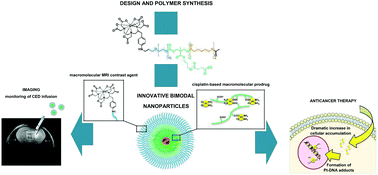Hybrid Gd3+/cisplatin cross-linked polymer nanoparticles enhance platinum accumulation and formation of DNA adducts in glioblastoma cell lines†
Abstract
Glioblastoma is the most frequent and aggressive primary malignant tumor of the central nervous system with a gloomy prognosis. Platinum derivatives and one among them, cisplatin, exhibited promising results when locally administered into the brain of glioblastoma bearing rats. Nanovectorization of anticancer agents through polymeric nanoparticles may even promote drug accumulation within cells, thus concentrating the drug efficiently at its target. Anchorage of gadolinium complexes on the corona of such smart drug delivery systems could further allow magnetic resonance imaging (MRI) monitoring of the nanoplatform biodistribution in the damaged parenchyma and its therapeutic benefit. For this purpose, a biocompatible amphiphilic triblock copolymer, made of degradable polyester and polycarbonate and bioeliminable polyethylene oxide (PEO), was synthesized by successive ring-opening polymerizations. After micellization in water, gadolinium complexes were grafted onto the PEO micelle corona and the carboxylate functions, located at the surface of the micelle's core, were able to cross-link with Pt(II) complexes. A macromolecular prodrug was therefore recovered in which more than one third of the carboxylate functions were linked to a platinum atom. By this strategy, stable cisplatin cross-linked nanoparticles were formulated with a mean size in the range of 100.63 ± 12.04 nm consistent with biological investigations. Relaxometry measurements both in water and in plasma at 7 T, 25 °C, confirmed the intrinsic potential of these hybrid nanoparticles as alternative MRI contrast agents with a substantial increase in the r2/r1 ratio by a factor of 3.3 and 2.7, respectively, compared to the conventional low molar mass Gd-DTPA. As a result, their infusion within the striatum of glioblastoma-bearing mice resulted in a hypersignal on T2-weighted MR images that persisted over time. Ultimately, the formulated prodrug exhibited up to 50-fold increased accumulation in human glioblastoma cell lines and up to 32-fold enhanced subsequent Pt-DNA adduct formation in comparison with free cisplatin, thus supporting the potential of this innovative bimodal tool for further applications.



 Please wait while we load your content...
Please wait while we load your content...